HAGURO-SAN
Home to Haguro Shugendo and the Dewa Sanzan Yamabushi mountain monks
The Heavenly Haven of Haguro-san in Yamagata Prefecture
Of the thousands of mountains in Yamagata, the prefecture literally made of mountains, one peak emphatically stands out from the rest: Haguro-san. Abode of yamabushi (mountain ascetics), and centre of spiritual journeys in Japan for over a millennium, Haguro-san (Mt. Haguro) is a small mountain that those on a spiritual journey, history buffs, hikers, nature-lovers, and plain Japanophiles alike are sure to love.
Haguro-san and The Dewa Sanzan: Mountains of Rebirth
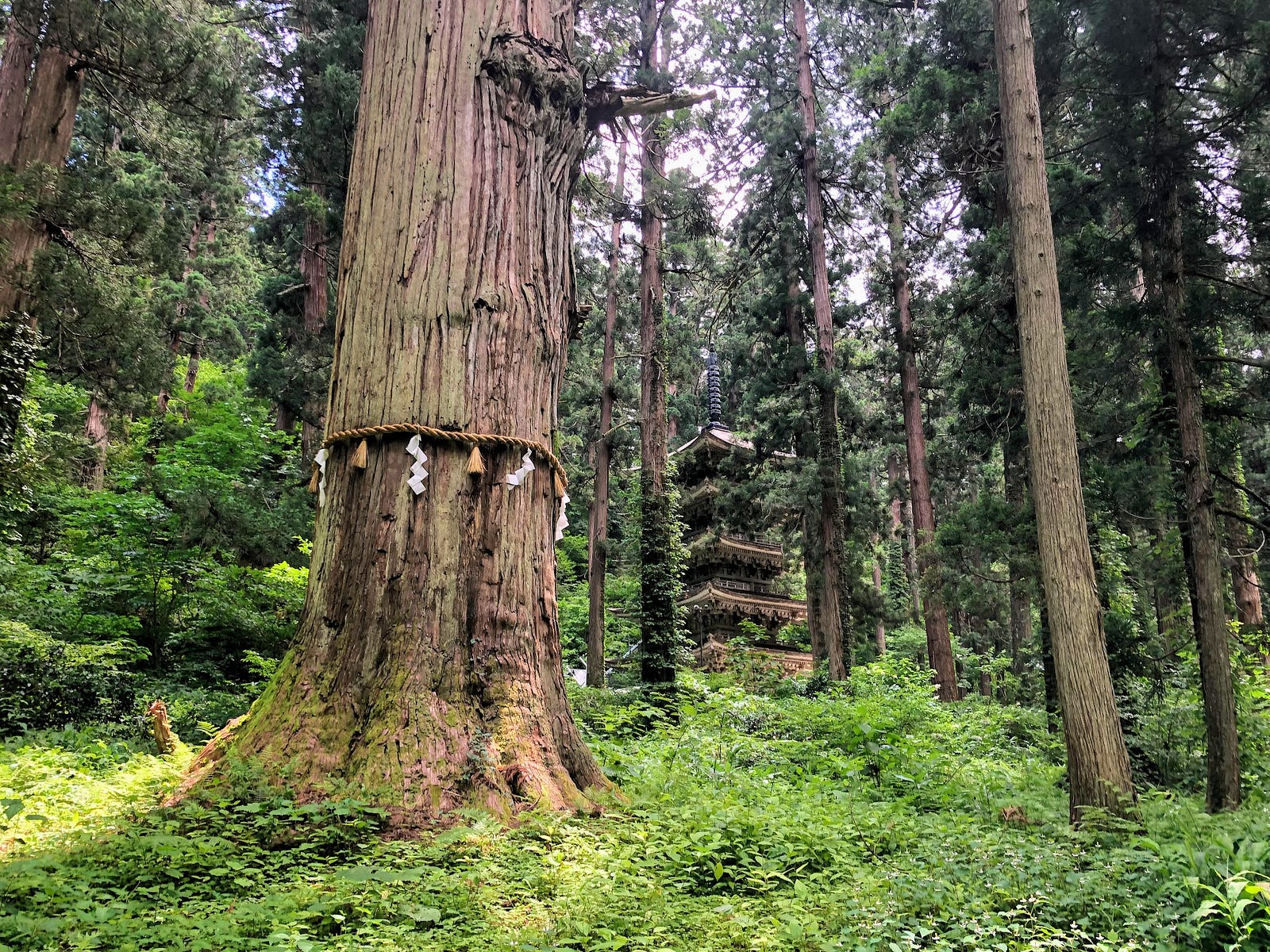
Dewa Sanzan is the collective term for the three sacred mountains in the former Dewa Province, modern-day Yamagata Prefecture: Haguro-san, Gassan, and Yudono-san. Since ancient times, anyone who traverses these three peaks is overcome with a feeling of euphoria akin to being ‘reborn’. Over the centuries, these three mountains built a reputation as ‘mountains of rebirth’, and climbing the three peaks became the ‘Journey of Rebirth’.
Representing the world of the present where we overcome our struggles in the current world, Haguro-san marks the first stop and official entrance of this journey of rebirth on the Dewa Sanzan peaks.
Yamabushi Rituals on Haguro-san
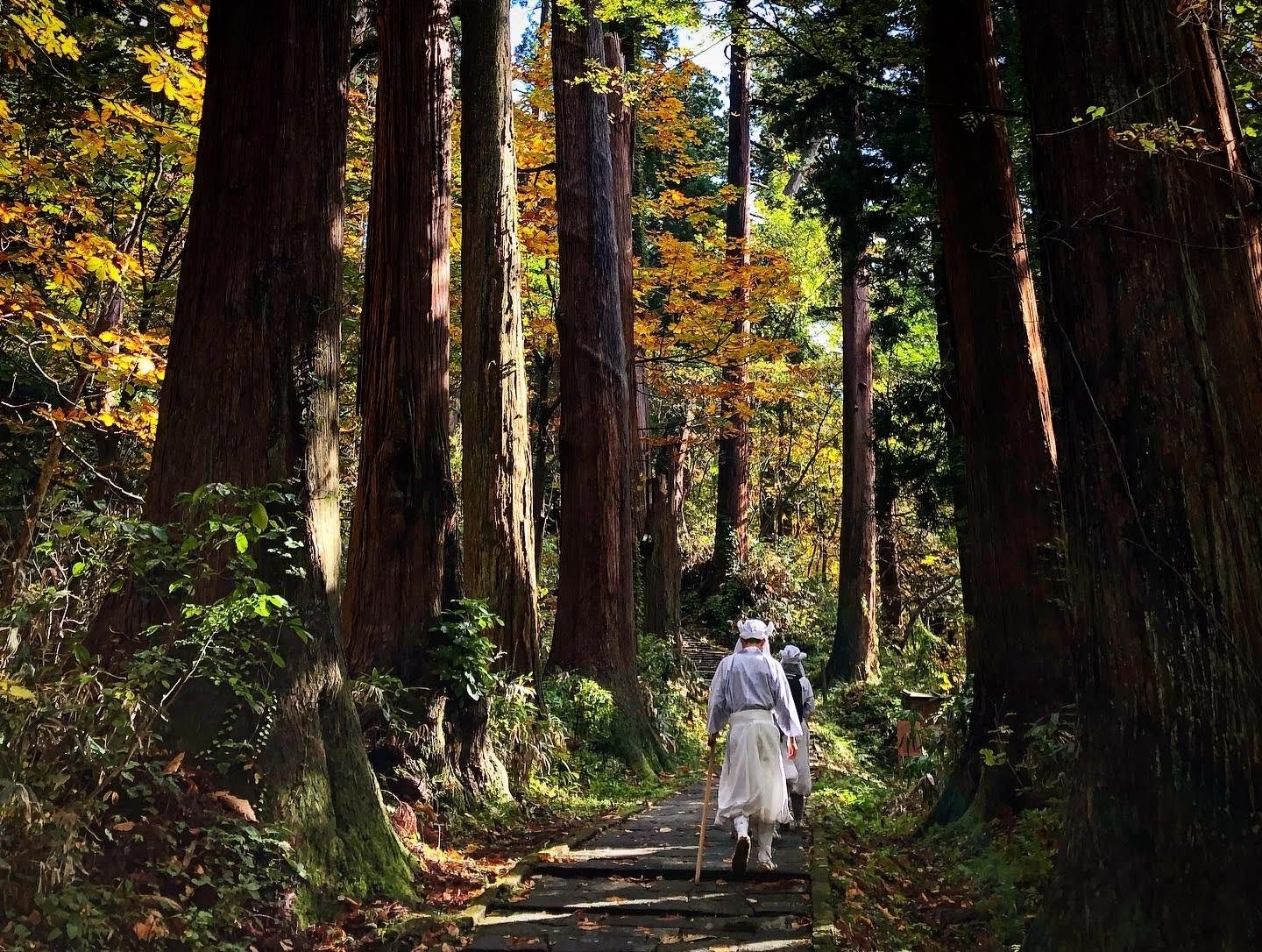
Haguro-san is known far and wide for hosting yamabushi Shugyo training, and the many yamabushi rituals taking place to this day. Perhaps most famous is the Akinomine Autumn’s Peak Ritual taking place at the end of August annually.
Every year on the penultimate night of the Akinomine, August 31st, the Hassakusai Festival at Prince Hachiko Shrine near the summit of Haguro-san takes place. In what is quite a spectacle, more than 150 yamabushi parade around an open bonfire all the while chanting in unison.
Or take, for example, the Shoreisai Festival on New Year’s Eve, the culmination of the 100-day Fuyunomine Winter’s Peak Ritual. Among many other fascinating events, part of the Shoreisai Festival is Otaimatsu-hiki. Here teams race to pull two giant burning effigies of a demon across a snowy field at the top of Haguro-san. This alone is worth waiting hours in the cold snow to watch, or if you’re lucky, even take part.
Keen? Experience the Dewa Sanzan Journey of Rebirth led by a yamabushi as has been custom for centuries. Or, if you’re really up to it, you can even try your hand at full-blown yamabushi Shugyo training.
Something (Everything) For The History Buffs
History buffs will be simply enamoured at how much Haguro-san has to offer. In fact, I couldn’t think of a better place to grasp how spirituality and religion evolved in Japan.
One important difference between the Dewa Sanzan and the popular Koya-san and the Kumano Kodo in Wakayama Prefecture is the strong Shinto influence. Whereas the remote location of Koya-san all but ruined any chance of anti-Buddhist sentiment reaching the Shingon sect stronghold, Haguro-san and the Dewa Sanzan mountains were adversely affected by Shinbutsu-bunri, the attempted split of Shintoism and Buddhism, in the late 1860s and 1870s.
Tumultuous Times in Japan’s History
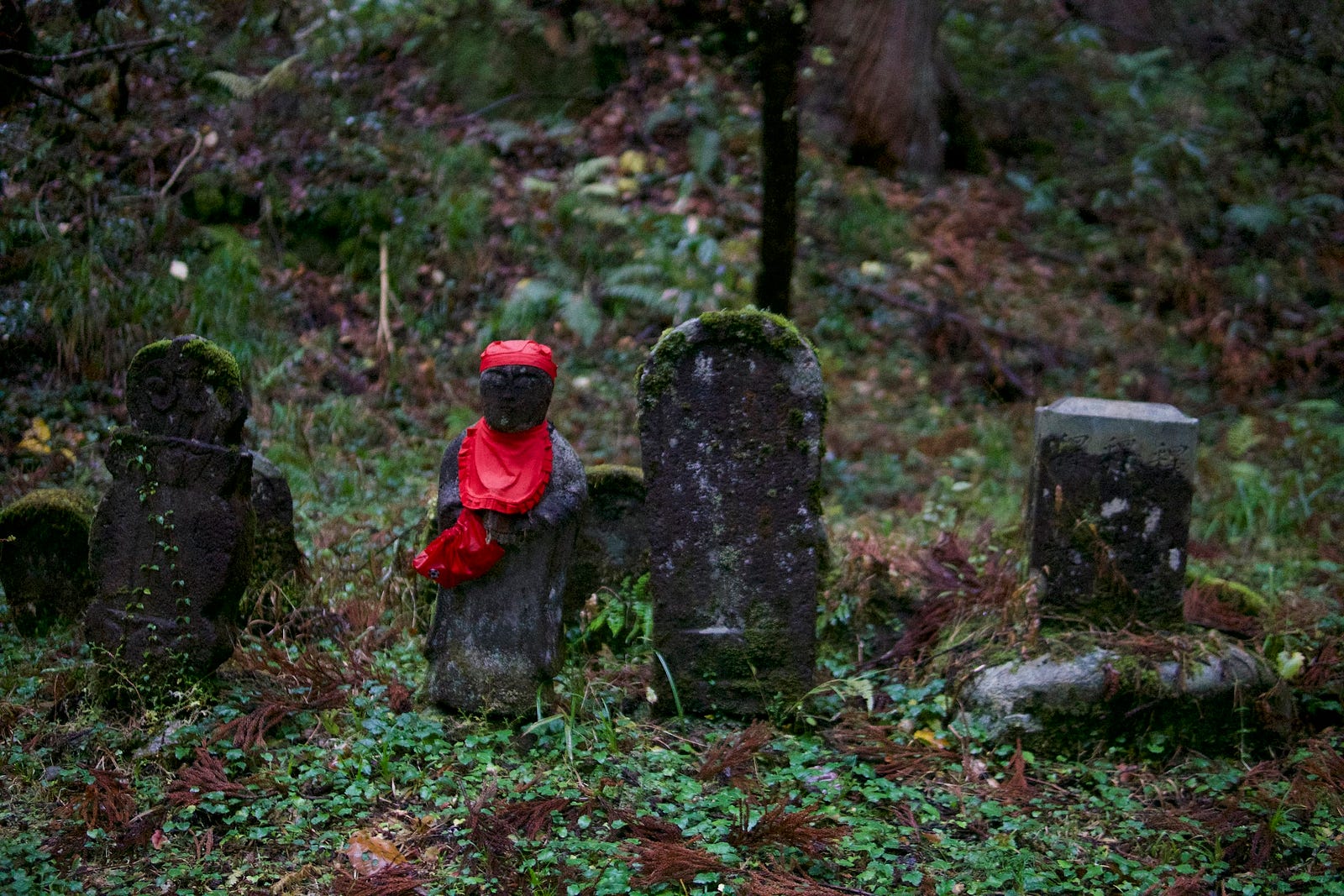
On Haguro-san, you can see the remnants firsthand. And let me tell you, it can be harrowing to witness.
The existence of a clearly Buddhist structure, the National Treasure Five Story Pagoda, on Shinto shrine grounds is reason enough. Curiously, however, right next to the pagoda there are some tiny statues of Jizo-sama, a Buddha commonly seen all over Japan. Shockingly, these statues have had their heads completely removed in what was no accident.
Plus, Haguro-san hosts two schools of yamabushi; Buddhist and Shinto. In fact, the Dewa Sanzan is the only place in the world Shinto yamabushi exist. This alone shows how the fusion, attempt at separation, and subsequent return of the fusion of Shinto and Buddhism played such an important role in how such an eclectic mix of belief systems came to coexist in Japan.
Hikers and Nature Lovers Rejoice
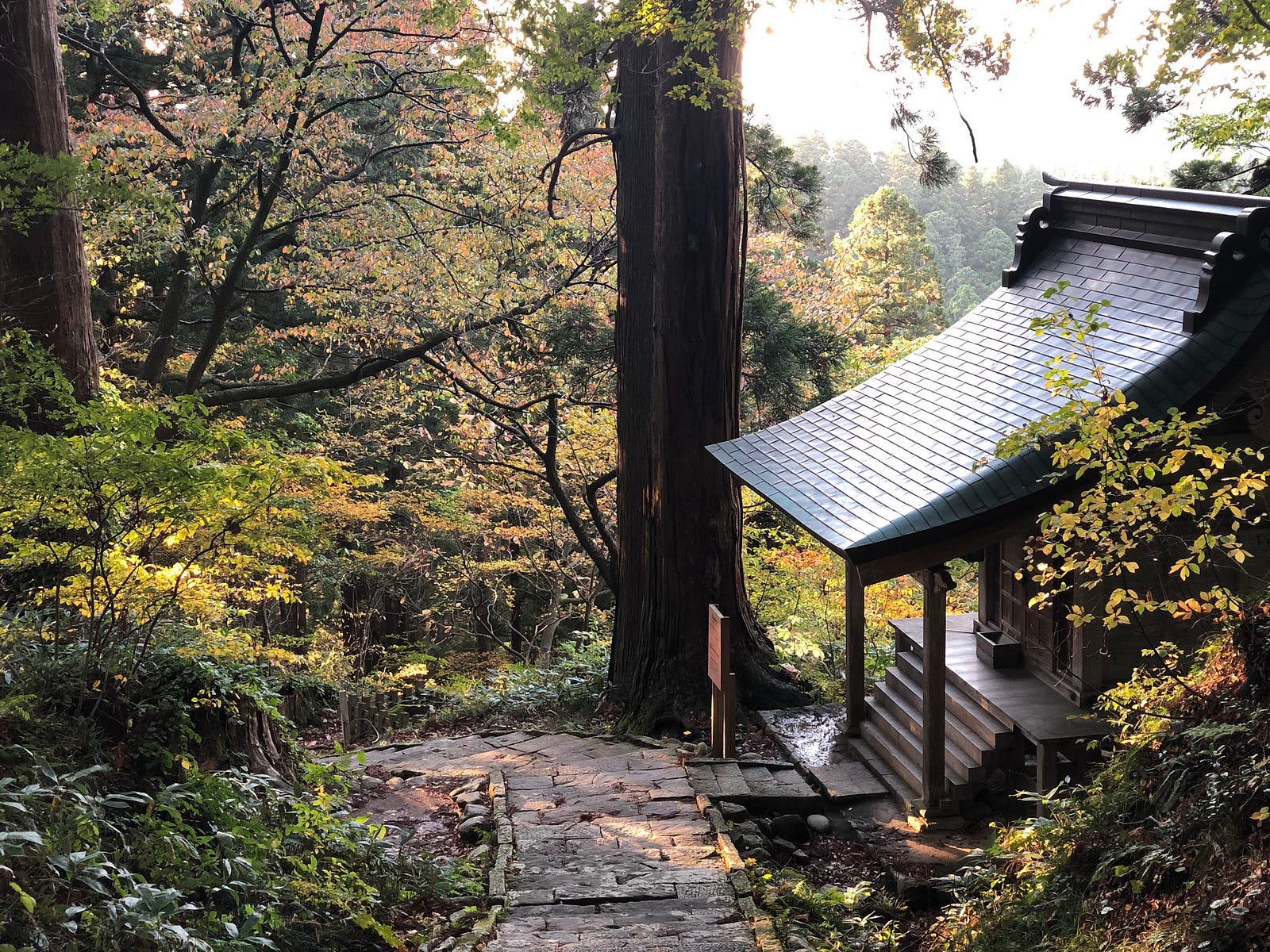
Put simply, Haguro-san is mecca for hikers.
Starting from the pilgrim’s lodge village of Toge, passing through the stark red Zuishinmon gates you will immediately be taken into another realm. This first decent takes you along Haguro-san’s famous stone stairway amongst the cedar forest, past countless massha shrines, over the Haraigawa (exorcism) river, past Suga-no-taki falls and the grandfather cedar, to the piece de resistance, Haguro-san’s National Treasure Five Story Pagoda.
From here, the real climb up the 2,446 steps starts. Along the way, be sure to stop at Ninosaka Chaya Tea House for some Chikara Mochi, literally ‘pounded rice cakes to help you power through’.
Here’s a yamabushi hint: if time allows, definitely also check out Minamidani where famed Haiku poet Matsuo Basho spent four nights while compiling Oku-no-hosomichi, The Narrow Road to The Deep North.
Before reaching the summit you will spot Dewa Sanzan shrine’s lodging, Saikan, and the aforementioned shrine to Prince Hachiko. Lastly, you will arrive at Sanjingosaiden, the collective hall of the three Dewa Sanzan Kami, home to Japan’s thickest thatch roof and Dewa Sanzan Jinja, where we pay our respects.
Alternate Trails up Haguro-san
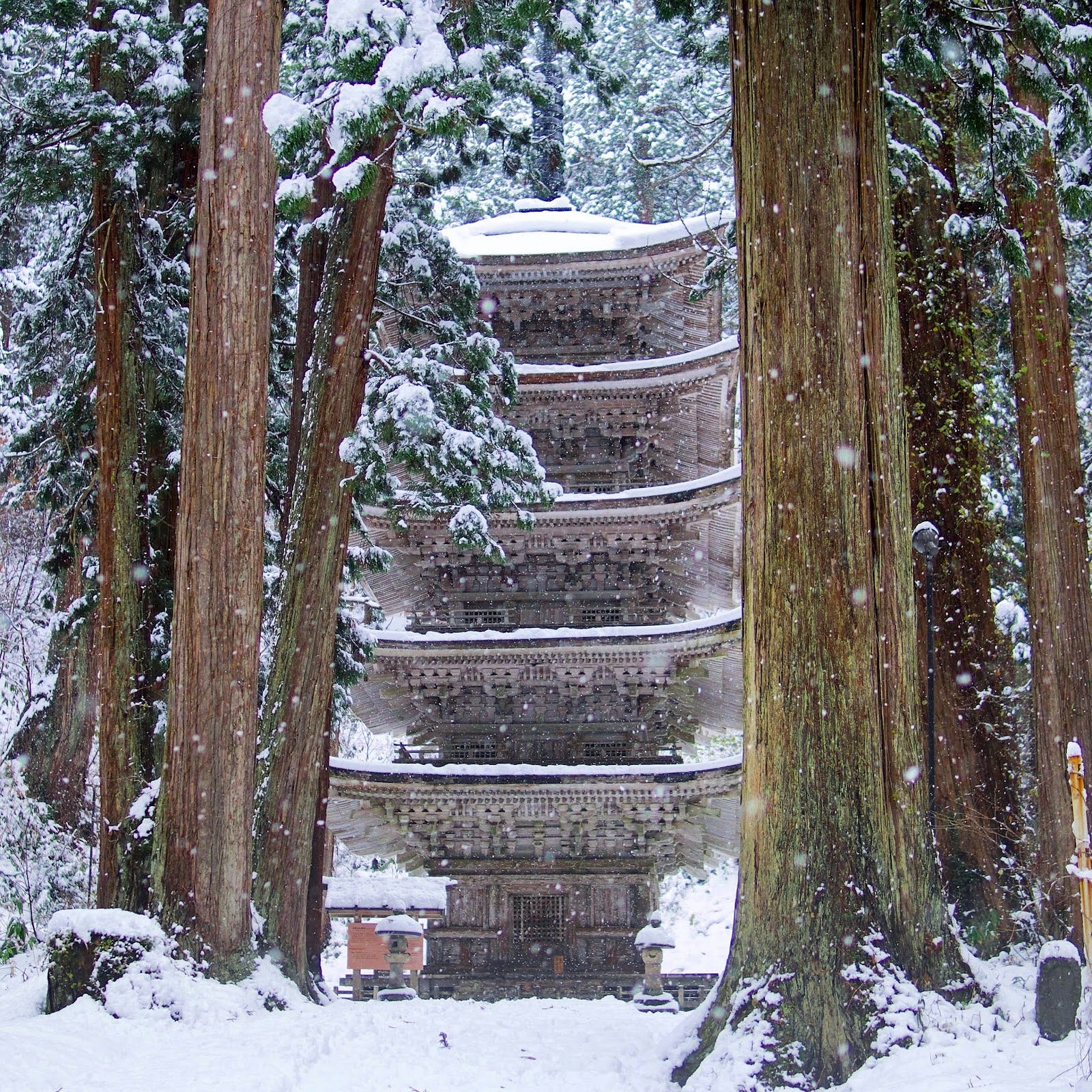
Alternatively, or additionally, try Haguro Kodo, the Haguro Legacy Trail (read on for more). This is a route completely unlike the traditional route, almost entirely through primeval forests, but with historical relics dotted all over the place.
Plus, unlike the two other Dewa Sanzan mountains, Haguro-san is open year-round. And let me tell you, the Five Story Pagoda under metres of snow sure is a sight to behold!
The Doorstep to Dewa
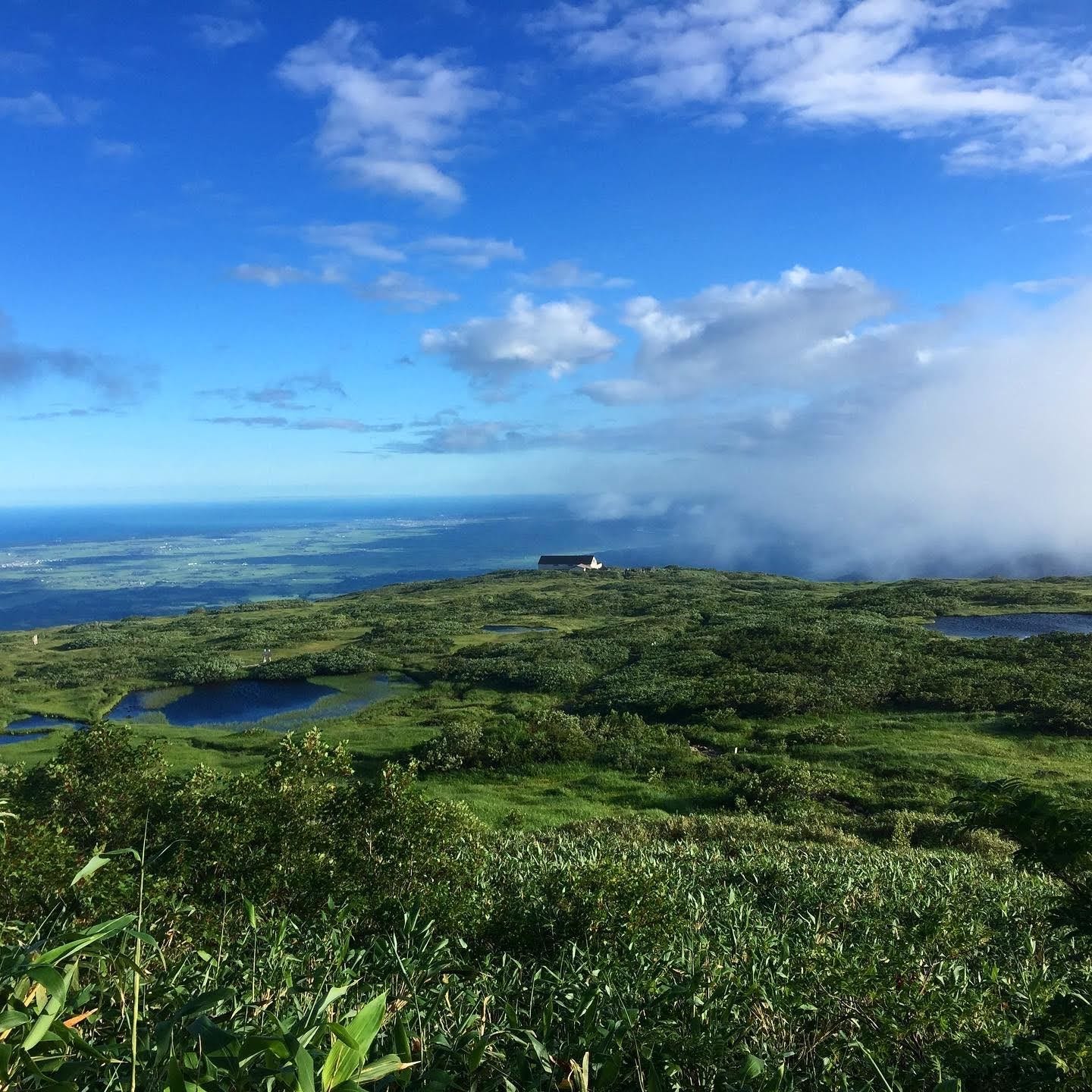
Haguro-san is quite literally the doorstep to the other Dewa Sanzan peaks, including one of the 100 Famous Mountains of Japan. Traditionally, the Haguro Trailhead was one of the official Happo Nanakuchi trailheads up Gassan.
A short hop skip and jump later and you’ll find yourself at the final Dewa Sanzan peak, Yudono-san. Home to an object of worship too sacred to mention. Yudono-san was also proving ground for Sokushinbutsu ‘Buddha Mummies’ or ‘Living Buddha’.
The Legend of Prince Hachiko
Legend has it that the Dewa Sanzan, the three sacred mountains of Dewa in modern-day Yamagata prefecture, were opened as a religious centre in 593 by Prince Hachiko, son of Emperor Sushun.
As the story goes, Emperor Sushun was assassinated by Soga-no-Umako of the Soga clan. Seeing the struggle of the everyday person, and at the shock of his father’s own death, Prince Hachiko decided to dedicate his life to providing salvation to the people through ascetic practice. Fearing for his cousin’s life, Prince Shotoku convinced Prince Hachiko to make tracks for Haguro-san as he had come across Avalokiteśvara (Kannon Bosatsu, Guanyin, or the Buddhist god of Mercy) there on his own travels.
Arriving at Yura
Prince Hachiko sailed north on the Sea of Japan and arrived at Yura on Tsuruoka’s southern coast, a spot I visited very recently before climbing Arakura-yama. Under the watchful eye of the mystical three-legged crow, a common theme in Japanese mythology, Prince Hachiko’s ascetic practice led him to Haguro-san where he came across Haguro Gongen, the deity of the mountain (Avalokiteśvara is the Honji Buddha of this Gongen). This eventually led to the founding of the Dewa Sanzan as religious grounds, which has obviously had a profound impact on the surrounding area for centuries, millennia even.
They say Prince Hachiko didn’t originally climb up the western Tsuruoka City side of Haguro-san, the side with the now famous Five Story Pagoda and stone stairway. Instead, Prince Hachiko’s journey up the legendary Dewa Sanzan allegedly began on the Shonai Town side in a hamlet conveniently known these days as Hachiko (with different Kanji 鉢子).
The Haguro Kodo is born
Now known as the Haguro Kodo (羽黒古道), the Haguro Legacy Trail, this path from Hachiko to the summit of Haguro-san is said to have prospered up until the Edo period (1603 to 1868), when literally millions of pilgrims each year ventured to the sacred Dewa Sanzan. You see, in those days travel between different regions of Japan was forbidden except for the higher classes, or those on religious pilgrimages. In other words, a religious pilgrimage was one way normal people could go and see other parts of this fair land, and many opted to visit the Dewa Sanzan.
If you’re familiar with Kabuki, you may have heard the story Kanjincho in which the famous warrior Minamoto no Yoshitsune, travelling with his porter Benkei, disguises himself as a Yamabushi to get through one of the checkpoints. This story also formed the basis for Akira Kurosawa’s The Men who Tread on the Tiger’s Tail. Minamoto no Yoshitsune is said to have stayed with Benkei in Goshonoji Shrine in Kiyokawa near the Haguro Kodo on their way to Hiraizumi in the modern-day Iwate prefecture.
Pilgrims would come off the Mogami River at the Kiyokawa checkpoint located at the base of the Tachiyazawa River, pay their respects at Goshonoji Shrine, and then climb Haguro-san using the Haguro Kodo.
The Haguro Legacy Trail: Haguro Kodo

The Haguro Kodo begins in Hachiko, a tiny hamlet on Route 47. Although the first part of the path is on a service road, you instantly find yourself in a serene forest of evergreens and are immediately overcome with its mystical energy. If the Jizo statues don’t make you feel like you are in a sacred area I don’t know what would.
Keep following the path up as it veers off to the right and you will come across an open area called Subeno(皇野). Subeno literally translates to ‘Imperial Field’, an homage to Prince Hachiko, who is said to have begun his ascetic training on the Dewa Sanzan in this very spot. This unsuspecting area is said to have prospered up until the Muromachi period (approximately 1336 to 1573) with up to 500 buildings, such as temples (大皇山満納寺) and Shukubo pilgrim lodges.
In the middle of Subeno, there are the remains of a building called Haguro-san Honsha, the main office of Haguro-san. This is believed to be the original Haguro-san office that over the centuries was located in many spots up the mountain until finding its way to Sanjingosaiden at the summit in 1818.
In Subeno, there are the remains of a small pond called Mitarase that was used for washing, and nearby there is an Inari shrine and monument dedicated to the ‘founder’ of the Dewa Sanzan, Prince Hachiko.
Artefacts Galore

The Haguro Kodo then takes you along a stream called Haguro Sawamizu, with numerous artefacts such as a small monument called Gyojazuka, which is believed to be Prince Hachiko (founder of the Dewa Sanzan)’s grave (there are at least two purported graves to Prince Hachiko, another one is at the top of Haguro-san).
On this monument there is some Sanskrit and also 「一世行者○海」(according to recent research, the circle is said to be the character 永 for longevity). This is most likely a monument to a local ascetic. Also, near the stream there is a monument called Hikyaku no Haka, the Grave of Hikyaku, said to be Prince Hachiko’s envoy. Chigozuka, another monument along the path is dedicated to a young monk said to have lost their life there.
The Grand Views of Haguro Kodo

Follow the Haguro Kodo signs up the mountain that lead through the dense forest. Before long, you will come out at an opening that reveals great views out to the Tachiyazawa Basin or if the weather is good, Chokai-zan. Once you make your way to the top of the hill, views out over the Shonai Plains and to the Sea of Japan await. Keep following the path and you will come across an access road that leads into a Beech and Cedar forest that eventually comes out at Reisaiden at the top of Haguro-san.
To be honest when I reached the summit I got quite a shock. I had probably visited that part of Haguro-san at least 20 times. Never did I realise there was a mountain path right there. Part of that might be because the Shrine seems to not want people to use the Haguro Kodo. I’m not sure why, but the path fails to appear in maps and there is zero signage at the summit. It could perhaps be because where it comes out is in fact a cemetery. Generally anything related to death is taboo in Shintoism. That too me only added to the mystery. Either way, I was really glad I got the chance to see things for myself.
Getting to the Haguro Kodo

There are two ways to get to the Haguro Kodo. First is to climb down from Reisaiden Shrine at the summit of Haguro-san. Second is to use a car. I’ve written all about how to get to Haguro-san in this article. For the Haguro Kodo there is a car park here, and the trailhead is here.
There are useful maps at the carpark. From the carpark, you will see a house that sits against the hill. There is a road that goes directly past this house leading straight into the forest. This is the Haguro Kodo.
Getting to Haguro-san
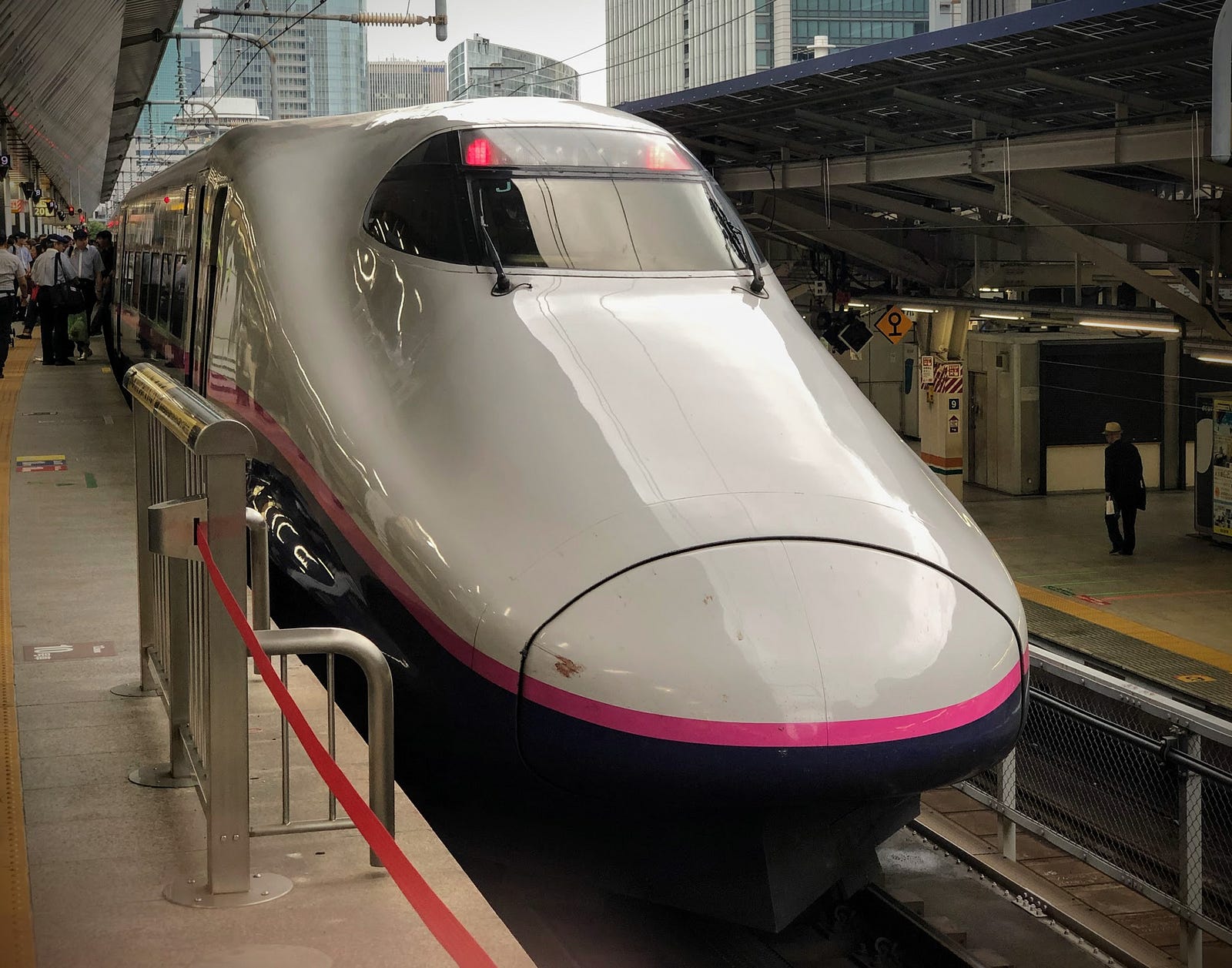
From Tokyo, the easiest way to get to Haguro-san is the one-hour flight to Shonai Airport from Tokyo Haneda. Then, you can either take a taxi, rental car, or the bus via Tsuruoka Station. However, I recommend taking the slow route: the Joetsu Shinkansen and Inaho Express to Tsuruoka.
Accommodation on Haguro-san
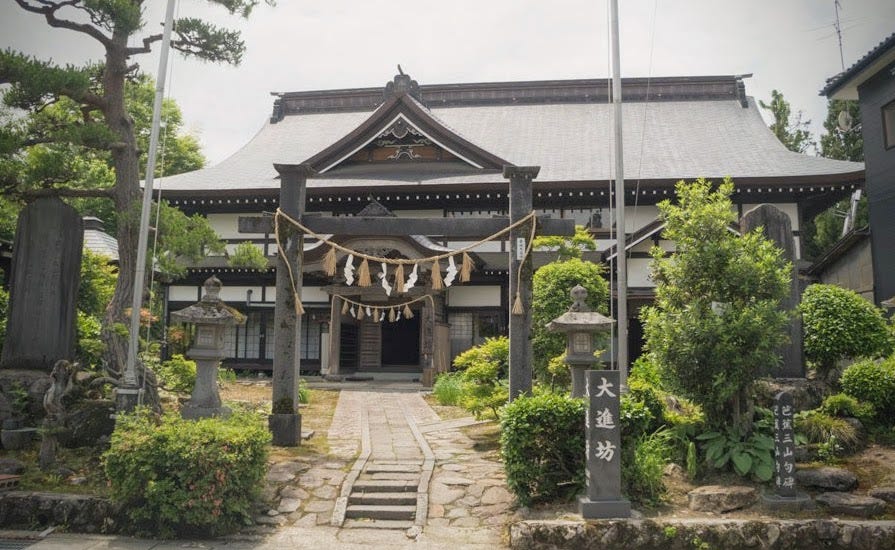
A trip to Haguro-san is not complete without staying in one of the Shukubo pilgrim’s lodges, purpose-built lodgings from the 17th century run exclusively by yamabushi.
Shukubo provide Dewa Sanzan Shojin Ryori, ascetic cuisine developed from what yamabushi ate for survival on the mountains. Plus, there are altars for rituals and prayers, yamabushi guides, Ofuda amulets, garments, and everything needed for your journey of rebirth. Especially recommended are Shukubo Daishinbo run by the Hayasaka Family for 17 generations, and Shukubo Daishobo run by Master Hoshino that hosts yamabushi trainings.
Although not technically a Shukubo, Saikan mentioned earlier is another great option for accomodation on Haguro-san. Unlike the Shukubo, Saikan is open year-round, even when inundated with metres of snow. Although any Shukubo will provide amazing meals, Saikan is especially known for the elaborate dishes chef Shinkichi Ito lovingly serves.
The Dewa Sanzan’s Haguro-san
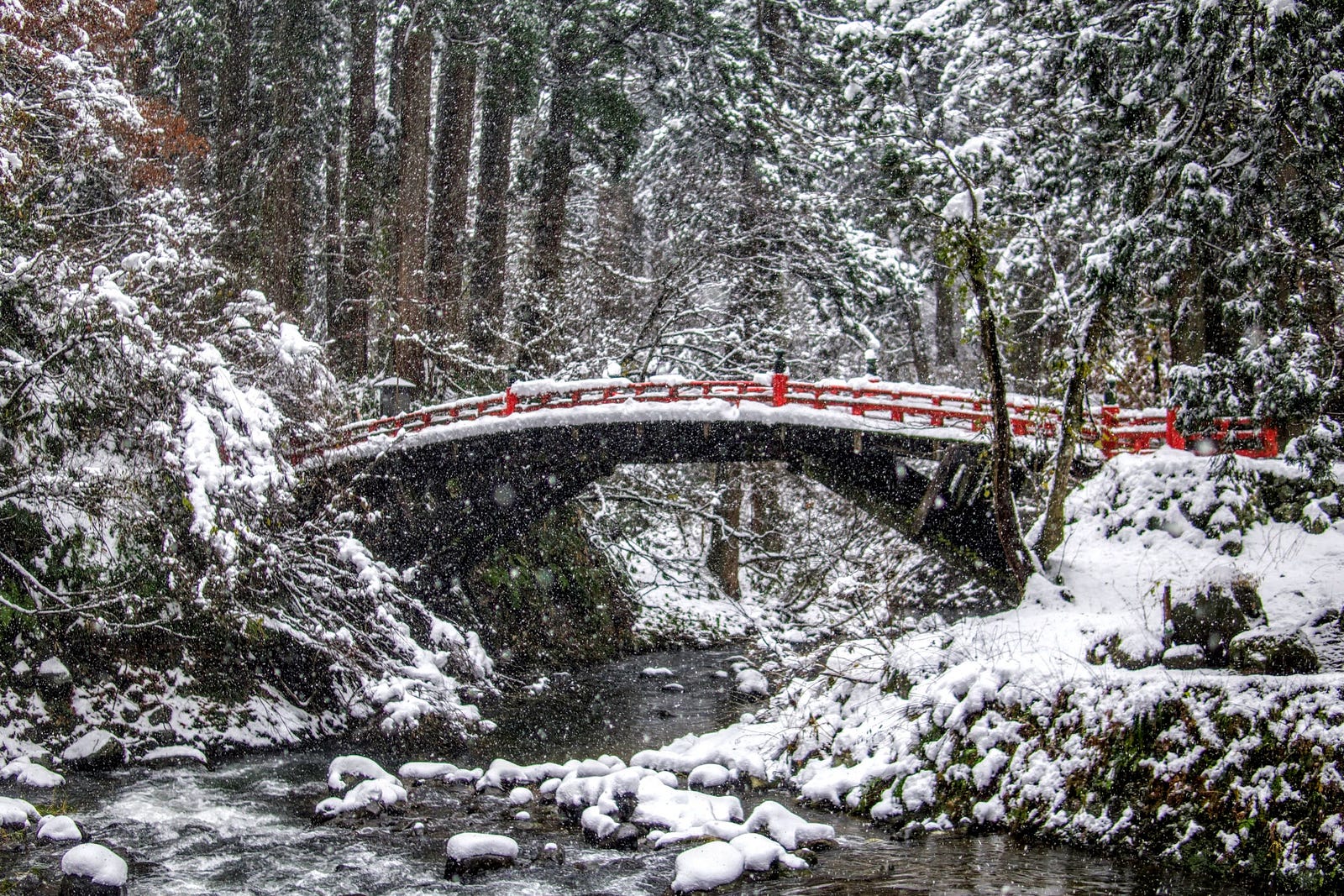
This tiny peak is one of the best places in Japan to learn about not only Japanese culture and history, but also about yourself. Plus, there’s plenty there for hikers and nature lovers alike. If you’re looking for a little-known haven off the beaten path in Japan, look no further than Haguro-san.
Haguro-san Videos
Nearby locations of interest
The Tsuruoka Side of Haguro-san

The summit of Haguro-san is also accessible by car. There you will find Dewa Sanzan Jinja in the building called Sanjingosaiden, The Collective Hall of the Three Kami. This is where each of the Dewa Sanzan kami are held during the winter months. Nearby Saikan is also a must-see. Try some of the most unique Shojin Ryori (Ascetic Cuisine) that Japan has to offer. Check out dewasanzan.com for more (I run the site).
Gyokusenji Temple

Gyokusen-ji Temple is a Soto-sect Zen temple located at the base of Haguro-san. Gyokusen-ji is perhaps most well known for its Japan Heritage gardens that are over 300 years old. While there, be sure to grab yourself a cup of freshly-whisked Maccha Green Tea and accompanying sweet. This is a great way to pass the time while looking out over the famous garden.
Gassan via the 8th Station

If you’re visiting Haguro-san and looking for even more of an adventure, I highly recommend hitting up Gassan. Gassan represents the world of the afterlife on the Dewa Sanzan Journey of Rebirth. The tallest Dewa Sanzan peak is where we come face to face with our ancestors. Gassan is only open from July to mid-October. This is because of the massive amounts of snow that accumulate on the peak annually. However, this means that the variety of landscapes to be seen is second to none. Use this map for the 8th Station on the Haguro-san side of the mountain.
Matsuyama, Sakata City

From Kiyokawa, it isn’t that hard to get to Matsuyama in Sakata City. Matsuyama is a former castle town. Here you will findsome of my favourite spots in the Shonai Region. For example, Somokusha Cafe, Sokoji Temple, and excellent views all over the Shonai region from Chokai-no-mori.
Genso no Mori: The Forest of Illusions

The Forest of Illusions, Genso no Mori, is a nearby forest full of natural cedar trees. Over time, the trees deformed into mangled shapes that give the forest a very special aura. The forest feels like being in the tentacles of an octopus, definitely check it out for yourself!
HAGURO-SAN
羽黒山 | はぐろさん
Mt. Haguro, Mount Haguro, Hagurosan
Haguro-san (Mt. Haguro, 羽黒山はぐろさん) is a 414m (1358 ft.) peak in the Shonai region of Yamagata prefecture best climbed from April to November (although, winter hiking is also very much recommended!). Haguro-san is a level 2 in terms of physical demand, which means it is relatively easy to hike, has a A technical grade, which means it requires little expertise, and you want to allow at least 2 hours for a climb.
Mountain Range
Gassan
Region
Shonai
Elevation
414m (1358 ft.)
Technical Demand
A (easiest)
Physical Demand
2 (A little difficult)
Trails
Two
Best time to climb
Year-round (need snowshoes or rain-boots in winter)
Day trip possible?
Yes
Minimum Time Required
3km length one way, 3 hours return
PDF Maps by TheHokkaidoCartographer and JapanWilds.org. See all here.
100 Mountains of Yamagata, abandoned buildings and ruins, Ancient paths and trails, Autumn Leaves, Bandai Asahi National Park, Buddhist Temples and Shinto Shrines, Dewa Sanzan, Favourites, Forest Bathing, Full Day Hikes, Half-day hikes, Hard to reach, Historical Hikes, Mountains below 500m, Myths and Legends, Shonai Region, Shonai Town, Short hikes, Shugendo Mountains, Tsuruoka City, Waterfalls, Wetlands, Winter Hikes, yamabushi
YAMABUSHI NEWSLETTER







